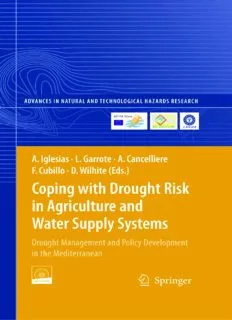
Coping with Drought Risk in Agriculture and Water Supply Systems: Drought Management and Policy Development in the Mediterranean PDF
Preview Coping with Drought Risk in Agriculture and Water Supply Systems: Drought Management and Policy Development in the Mediterranean
Coping with Drought Risk in Agriculture and Water Supply Systems Advances in Natural and Technological Hazards Research VOLUME26 Forfurthervolumes:http://www.springer.com/series/6362 Coping with Drought Risk in Agriculture and Water Supply Systems Drought Management and Policy Development in the Mediterranean Edited by Ana Iglesias DepartmentofAgriculturalEconomicsandSocialSciences, UniversidadPolite´cnicadeMadrid,Spain Luis Garrote DepartmentofCivilEngineering, UniversidadPolite´cnicadeMadrid,Spain Antonino Cancelliere DepartmentofCivilandEnvironmentalEngineering, UniversityofCatania,Italy Francisco Cubillo CanaldeIsabelII,Madrid,Spain and Donald A. Wilhite NationalDroughtMitigationCenter, UniversityofNebraska,NE,USA 123 Editors Dr.AnaIglesias Dr.LuisGarrote UniversidadPolite´cnicadeMadrid UniversidadPolite´cnicadeMadrid Depto.Econom´ıayCienciasSociales Dpt.Ingenier´ıaCivil:Hidrau´licay Agrarias Energe´tica Av.Complutense,s/n Av.Complutense,s/n 28040Madrid,Spain 28040Madrid,Spain [email protected] [email protected] Dr.AntoninoCancelliere Dr.FranciscoCubillo Universita`diCatania CanaldeIsabelII Dipto.IngegneriaCivilee SantaEngracia,125 Ambientale 28003Madrid VialeAndreaDoria,6 Spain 95125Catania,Italy [email protected] [email protected] Dr.DonaldA.Wilhite UniversityofNebraska SchoolofNaturalResources NationalDroughtMitigationCenter 239L.W.ChaseHall LincolnNE68583-0749 USA [email protected] ThisbookhasbeenwrittenwithintheframeworkoftheMEDROPLAN(MediterraneanDroughtPre- paredness and Mitigation Planning) Project, co-funded by the European Union through the Euro- Mediterranean Regional Programme for Local Water Management (MEDA Water) and the Mediter- raneanAgronomicInstituteofZaragoza-CIHEAM(Spain;Coordinator),UniversidadPolite´cnicade Madrid(Spain),UniversityofCyprus(Cyprus),NationalTechnicalUniversityofAthens(Greece),Uni- versityofCatania(Italy),InstitutAgronomiqueetVe´te´rinaireHasanII(Morocco),CanaldeIsabelII (Spain), Confederacio´n Hidrogra´fica del Tajo (Spain), Fundacio´n Ecolog´ıa y Desarrollo (Spain) and Ministe`redel’Agriculture,del’EnvironnementetdesRessourcesHydrauliques(Tunisia). ISBN:978-1-4020-9044-8 e-ISBN:978-1-4020-9045-5 DOI10.1007/978-1-4020-9045-5 LibraryofCongressControlNumber:2008938018 (cid:2)c SpringerScience+BusinessMediaB.V.2009 Nopartofthisworkmaybereproduced,storedinaretrievalsystem,ortransmitted inanyformorbyanymeans,electronic,mechanical,photocopying,microfilming,recording orotherwise,withoutwrittenpermissionfromthePublisher,withtheexception ofanymaterialsuppliedspecificallyforthepurposeofbeingentered andexecutedonacomputersystem,forexclusiveusebythepurchaserofthework. Printedonacid-freepaper 9 8 7 6 5 4 3 2 1 springer.com Preface Overthelastthreedecadesdroughtepisodeshaveresultedinseveresocialproblems inMediterraneancountries,receivingwideattentionfromtheinternationalscientific and policy communities. The experiences in the development and implementation ofdroughtmanagement planshighlightthesuccessandchallenges ofcopingwith droughtforsocietieswithdifferentvulnerabilities.Basedontheseexperiencesand thecurrentmethodsforevaluatingrisk,thebooksynthesisesguidelinesfordrought managementthatcanbeappliedtootherregions. Thisbookaddressesthegrowingissueofdroughtpreparednessplanning,mon- itoring, and mitigation, which has worldwide application. The methodologies and lessonslearnedarefocusedonaspecific,drought-proneregionsotheapplications have more significance. The Mediterranean is a region that has been identified as likelytoexperiencesignificantclimatechangesinfuturedecadesbecauseofincreas- ing greenhouse gas emissions and other factors. Preparing for climatic extremes (i.e.,managingclimatevariability)isanimportantfirststepinpreparingforclimate change. Finally, the Mediterranean region exemplifies many other drought-prone regions with rapidly expanding populations that are placing increased pressure on alreadylimitedwatersupplies. Thebookcomprisesseveralchaptersdividedintothreesectionsthatappealtoa broadaudience.First,thepolicy,socialandhydrologicalcontextofMediterranean countriesispresented,discussingtheinteractionsthathaveresultedinthecomplex institutionalframework,andhighlightingthecommonelementsthatsupportfurther droughtpolicydevelopment.Droughtmonitoringisacommonelementinallcases and is the essential first step for moving from disaster to risk management. This sectionemphasisestheroleoforganizations,institutions,andcivilstakeholdersin- volved in drought preparedness and mitigation and/or on water management for designingeffectiverisk-basedstrategiesthatmitigatetheeffectsofdroughtinagri- culture, water supply systems, and the environment. Finally, this section includes a chapter that presents guidelines for developing drought management plans. The managementactionsrelatedtoagricultureandwatersupplysystemsarepresented with a common conceptual framework based on the use of drought indicators for evaluating the levels of drought risk (pre-alert, alert, and emergency), that allow linkagesbetweenscienceandpolicytobeestablished. v vi Preface Second, the book presents scientific approaches to risk evaluation, including characterization of drought episodes, development of indicators of risk in agricul- tural and water supply systems, and analysis of the role of economic instruments andgroundwaterforriskmitigation.Thissectionfinaliseswiththedescriptionofan integrated method for evaluating social vulnerability and a discussion of methods forsocialparticipationtosolvewater-relatedconflicts. The third section includes a collection of case studies with the description of effective measures taken in the past. These case studies provide the context for developingdemand-drivenguidelinesthatmaybeappliedtootherregions.Theau- thorsofthesechapterscanbeviewedasstakeholdersindroughtmanagementsince they represent a broad range of sectors and institutions from Mediterranean Euro- pean and North African countries. The topics addressed have implications for the internationalpolicycommunityinterestedindisastermitigation,agriculturalpolicy, anddevelopment. This book is mainly a result of the collaborative research carried out within the framework of the Medroplan project (supported by the European Union MEDA-Water Programme) that analyses drought and water scarcity management in Mediterranean countries promoting a risk-based preparedness and mitigation approach.Themulti-disciplinaryeffortsoftheMedroplanteamsproducedasystem- aticapproachtoassistinthedevelopmentofdroughtandwaterscarcitymanagement plans linking science and policy (http://www.iamz.ciheam.org/medroplan). The contributionofallMedroplanresearchteamsandcollaboratorsisacknowledgedfor theirvaluableinput.Weacknowledgethesupportoftheparticipantinstitutionsand especially the Mediterranean Agronomic Institute of Zaragoza (IAMZ-CIHEAM) that coordinated the project and continues to support the NEMEDCA Network on DroughtManagementfortheNearEast,MediterraneanandCentralAsia. Madrid,Spain AnaIglesias Madrid,Spain LuisGarrote Catania,Italy AntoninoCancelliere Madrid,Spain FranciscoCubillo Lincoln,NE DonaldWilhite Acknowledgment ThisbookcouldonlyberealizedthankstopricelesscontributionsofAntonioLo´pez- Francos of CIHEAM and Marta Moneo of the UPM coordinating the work of all authorsduringthefouryearsoftheMEDROPLANproject. vii Contents PartI ChallengestoDroughtManagementinMediterraneanCountries 1 DroughtMonitoringasaComponentofDroughtPreparedness Planning ...................................................... 3 DonaldA.Wilhite 2 Soft Law Principles for Improving Drought Management inMediterraneanCountries..................................... 21 EstherLo´pez-BarreroandAnaIglesias 3 AChecklistforDroughtPolicyDevelopment...................... 37 NicosX.Tsiourtis 4 An Environmental Focus on Drought: The Water Framework Directive ...................................................... 43 AbelLaCalleMarcos 5 GuidelinestoDevelopDroughtManagementPlans ................ 55 AnaIglesias,LuisGarroteandAntoninoCancelliere PartII MethodsandApproachesforDroughtManagement 6 DroughtCharacterisationintheMediterranean................... 69 G.TsakirisandD.Pangalou 7 AParadigmforApplyingRiskandHazardConceptsinProactive Planning ...................................................... 81 G.Tsakiris ix x Contents 8 AssessmentofDroughtRiskinWaterSupplySystems.............. 93 AntoninoCancelliere,VincenzoNicolosiandGiuseppeRossi 9 MathematicalModelsforReservoirOperationinTunisia...........111 M.H.LouatiandF.Lebdi 10 Risk Management Instruments Supporting Drought Planning andPolicy.....................................................133 AlbertoGarridoandAlmudenaGo´mez-Ramos 11 MethodsforEvaluatingSocialVulnerabilitytoDrought............153 AnaIglesias,MartaMoneoandSoniaQuiroga 12 MethodsforSocialParticipationandConflictResolution...........161 IgnacioCelaya,AntonioRodr´ıguezPereaandXaviCarbonell PartIII LearningfromtheCaseStudies 13 DevelopmentofDroughtManagementPlansinSpain ..............175 LuisGarrote,AnaIglesiasandFranciscoFlores 14 CharacterizingDroughtRiskinaSicilianRiverBasin .............187 Giuseppe Rossi, Brunella Bonaccorso, Vincenzo Nicolosi andAntoninoCancelliere 15 TheRoleofGroundwaterDuringDrought........................221 Mar´ıa Casado Sa´enz, Francisco Flores Montoya andRobertoGildeMingo 16 DroughtSeverityThresholdsandDrought ManagementinGreece .........................................243 D.Pangalou,D.Tigkas,H.Vangelis,G.Tsakiris andA.Nanou-Giannarou 17 UsingandTestingDroughtIndicators ............................257 LuisGarc´ıaAmor,AlejandroCarrascoandJuanCarlosIba´n˜ez 18 DroughtManagementintheUrbanWaterSupplySystemofCanal deIsabelII,Spain..............................................273 FranciscoCubillo
Description: